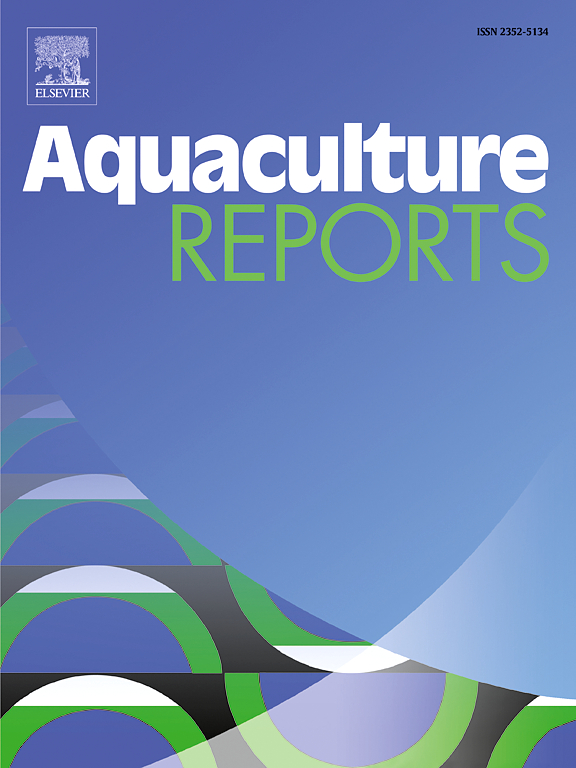急性和慢性氨暴露对杂交鲤鱼存活、生长和肠道菌群组成的影响
IF 3.2
2区 农林科学
Q1 FISHERIES
引用次数: 0
摘要
长期低氨环境下鱼类生长耐受阈值的评估对水产养殖水质管理具有重要意义。本研究采用序贯法评价杂交鲤鱼对急性和慢性氨暴露的耐受性。在第一阶段,我们估计了急性高氨胁迫对杂交鲤鱼的影响,并基于线性插值(y = 0.0047x - 0.4659,其中R2 = 0.9448, y代表累积死亡率,x代表氨浓度),确定了96 h的LC50为206.38 mg/L的总氨(TA)。在第二阶段,长期低氨暴露范围为(<;测定96 h LC50值分别为0.001(对照)、1.03 (LC50/200)、2.05 (LC50/100)、4.11 (LC50/50)、8.21 (LC50/25) mg/L TA,然后进行为期6周的实验。结果表明,氨浓度升高(>;1.03 mg/L TA)显著减少食物摄入量。当氨浓度高于1.03 mg/L TA时,生长性能受到抑制,当氨浓度高于4.11 mg/L TA时,存活率下降。游离氨基酸(精氨酸、亮氨酸、天冬氨酸和谷氨酰胺)的缺乏不仅影响鱼的生长,而且抑制了尿素循环中关键酶(精氨酸酶和精氨酸琥珀酸裂解酶)的活性,导致鱼的氨解毒能力下降。即使暴露于低浓度的氨(2.05 mg/L TA)也会降低抗氧化酶(超氧化物歧化酶和过氧化氢酶)的活性,引起肝损伤和炎症。长期低氨暴露降低了肠道微生物群的丰富度和多样性,同时增加了有害细菌的相对丰度,如Leifsonia, Aeromonas,丹毒杆菌和不动杆菌。有益菌(如鲸杆菌)相对丰度的增加可能是对抗氨毒性的一种应对策略。我们建议不要将杂交鲤鱼长时间暴露在超过1.03 mg/L TA的氨浓度中。本文章由计算机程序翻译,如有差异,请以英文原文为准。
Effects of acute and chronic ammonia exposure on survival, growth and intestinal microbiota composition of hybrid carp
It is very important to evaluate the growth tolerance threshold of fish under long-term low ammonia exposure for water quality management in aquaculture. This study employed a sequential method to evaluate the tolerance of hybrid carp to both acute and chronic ammonia exposure. In stage 1, we estimated the effects of acute high ammonia stress on hybrid carp and based on linear interpolation (y = 0.0047x - 0.4659, where R2 = 0.9448, with y representing cumulative mortality and x representing ammonia concentration), the 96-h LC50 was determined to be 206.38 mg/L of total ammonia (TA). In stage 2, the long-term low ammonia exposure ranges (< 0.001 (control), 1.03 (LC50/200), 2.05 (LC50/100), 4.11 (LC50/50), and 8.21 (LC50/25) mg/L TA) were determined based on 96-h LC50 value, and then a 6-week experiment was performed. The results showed that elevated ammonia concentration (> 1.03 mg/L TA) significantly reduced food intake. The growth performance was inhibited at ammonia concentrations above 1.03 mg/L TA, while survival rate decreased at ammonia concentrations above 4.11 mg/L TA. The lack of free amino acids (arginine, leucine, aspartic acid, and glutamine) not only affect the fish growth, but also inhibits the key enzymes (arginase and argininosuccinic acid lyase) activity in urea cycle, resulting in a decrease in ammonia detoxification ability. Even exposure to low concentration of ammonia (2.05 mg/L TA) can reduce the activity of antioxidant enzymes (superoxide dismutase and catalase), causing liver damage and inflammation. Long-term low ammonia exposure reduces intestinal microbiota richness and diversity while increasing relative abundance of harmful bacteria, such as Leifsonia, Aeromonas, Erysipelothrix, and Acinetobacter. And the increase in relative abundance of beneficial bacteria such as Cetobacterium may be a coping strategy against ammonia toxicity. We recommend against exposing hybrid carp to ammonia concentrations exceeding 1.03 mg/L TA for prolonged periods of time.
求助全文
通过发布文献求助,成功后即可免费获取论文全文。
去求助
来源期刊

Aquaculture Reports
Agricultural and Biological Sciences-Animal Science and Zoology
CiteScore
5.90
自引率
8.10%
发文量
469
审稿时长
77 days
期刊介绍:
Aquaculture Reports will publish original research papers and reviews documenting outstanding science with a regional context and focus, answering the need for high quality information on novel species, systems and regions in emerging areas of aquaculture research and development, such as integrated multi-trophic aquaculture, urban aquaculture, ornamental, unfed aquaculture, offshore aquaculture and others. Papers having industry research as priority and encompassing product development research or current industry practice are encouraged.
 求助内容:
求助内容: 应助结果提醒方式:
应助结果提醒方式:


